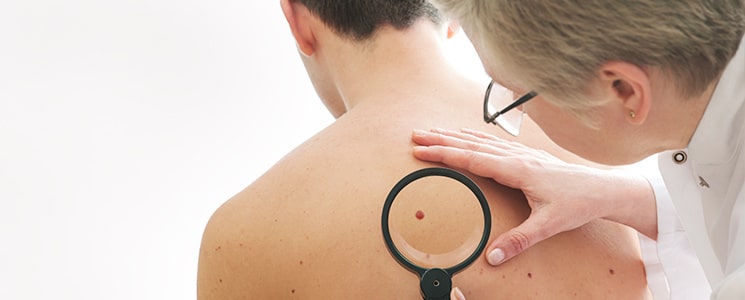
Skin Cancer
Skin cancer, which is the most common form of cancer in the United States, is the result of the abnormal growth of skin cells. Cancer can affect skin anywhere on the body, but most frequently appears on skin that is exposed to the sun. There are more than a million new cases of skin cancer in the United States each year.
What Causes Skin Cancer?
Every day, skin cells die and new ones form to replace them in a process controlled by DNA. Skin cancer can form when this process does not work properly because of damage to DNA. New cells may form when they are not needed, or older cells may not die, both of which can cause a growth of tissue known as a tumor. DNA damage is often a result of ultraviolet radiation from sunlight or tanning lamps. In some cases, skin cancer affects areas of the skin that have not been exposed to the sun. Certain factors, such as fair skin, moles, a weakened immune system, heredity and age, also increase the risk of skin cancer.
Types of Skin Cancer
There are three major types of skin cancer, and they affect different layers of the skin. They are named for the different types of skin cells that become cancerous.
Basal Cell Carcinoma
Basal cell skin cancer occurs in the basal cell layer of the skin and is the most common type of skin cancer in people with fair skin. It commonly occurs on areas of the skin that have been exposed to the sun, such as the face. It rarely spreads to other parts of the body.
Squamous Cell Carcinoma
Squamous cell carcinoma occurs in the squamous cells, and is the most common type of skin cancer in people with dark skin, who typically get it in places, such as the legs or feet, that have not been exposed to the sun. In people with fair skin, it usually occurs in sun-exposed areas such as on the face, head, ears and neck. Squamous cell skin cancer can spread to other parts of the body.
Melanoma
Melanoma is the most aggressive type of cancer, and the most likely to spread to other parts of the body. Melanoma occurs in the melanocyte (pigment) cells of the skin, and can form on any part of the body, regardless of past sun exposure.
The ABC’s of Skin Cancer
For early detection of Melanoma, follow the ABCDEs of Skin Cancer
A
Asymmetry
Uneven shape or pattern
B
Borders
Outer edges uneven
C
Color
Dark black or multiple colors
D
Diameter
Greater than 6mm
E
Evolving
Changing size/shape/color
Request a Consultation
We would love to meet with you to discuss your specific goals and concerns. Contact our practice for more information or to schedule your appointment today.
Patient Reviews
“Can’t say enough about this practice. All the staff are courteous & professional, and the offices are spotless clean. Brittany Eberly, PA & her assistants are always friendly, have great chair side demeanor, and give an extremely thorough total body evaluation. She takes the time to explain anything she sees and is willing to answer any questions you have……and actually engages in friendly banter throughout your visit!! Sorry I was a couple minutes late Brittany……yet you still came in with a smile & a happy face!!! LOVE this place!!!”
- Frank
Symptoms of Skin Cancer
Skin cancer is often identified as a new or changed growth on the skin of the scalp, face, lips, ears, neck, chest, arms, hands or legs. Although these are common areas for skin-cancer growths to form, they can occur anywhere, and manifest themselves as the following:
- Pearly or waxy bump
- Flesh-colored or brown scar-like lesion
- Firm, red nodule
- Crusted, flat lesion
- Large brown spot with darker speckles
- Shiny, firm bumps
A mole that changes shape or color can also indicate skin cancer.
Diagnosis of Skin Cancer
To diagnose skin cancer, a doctor reviews all symptoms, and checks the skin for any unusual growths or abnormal patches of skin. If skin cancer is suspected, a biopsy is performed on the growth or area of skin in question. Once the results of the biopsy are reviewed, the type of cancer can be determined, and a treatment plan created. Those who experience any skin changes, or have changes to existing moles or birthmarks, should see a doctor as soon as possible; early detection is key in successfully treating skin cancer.
Treatment for Skin Cancer
Treatment for skin cancer depends on the type, size and location of the tumor. Most options include the removal of the entire growth, and are effective forms of treatment. Removal procedures are usually simple, requiring only a local anesthetic in an outpatient setting. Some of the treatment options for skin cancer include the following:
- Freezing
- Excision
- Laser therapy
- Mohs surgery
Depending on the stage and severity of the skin cancer, in addition to removal of the growth, chemotherapy and radiation may be recommended.
Prevention of Skin Cancer
Although not every case of skin cancer can be prevented, the best way to avoid it is to protect skin from the sun. Recommendations for preventing skin cancer include the following:
- Limit exposure to the skin, especially between 10 a.m. and 4 p.m.
- Always wear sun screen with an SPF of at least 15
- Wear a hat in the sun
- Wear long sleeves and long pants
- Avoid tanning beds and salons
Performing routine self-exams to spot skin changes, and seeing a dermatologist for a full-body screening on a regular basis, is also recommended.






